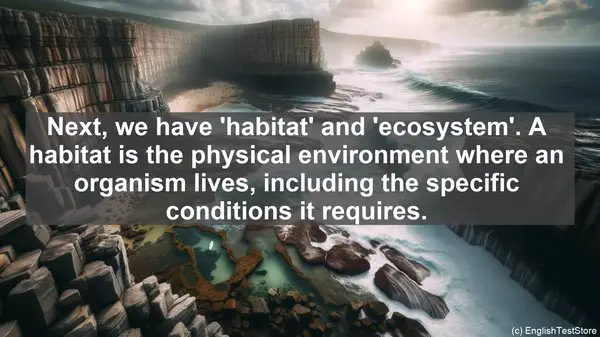Introduction
Welcome to today’s lesson on fisheries ecology. In this lesson, we will be focusing on a topic that often leads to confusion – words. Specifically, we will be discussing the top 10 commonly confused words in this field. By the end of this lesson, you’ll have a clear understanding of these terms and be able to use them correctly in your studies. So, let’s dive in!
1. Population vs. Community
The first pair of words that often causes confusion is ‘population’ and ‘community’. While both refer to groups of organisms, they differ in scale. A population consists of individuals of the same species in a given area, whereas a community includes all the populations of different species in that area. So, when you’re studying the interactions between different species, you’re looking at the community level.
2. Habitat vs. Ecosystem
Next, we have ‘habitat’ and ‘ecosystem’. A habitat is the physical environment where an organism lives, including the specific conditions it requires. On the other hand, an ecosystem is a more comprehensive concept. It not only includes the physical environment but also the interactions between organisms and their environment. So, while a habitat is like an organism’s address, an ecosystem is like its entire neighborhood.

3. Biotic vs. Abiotic
Moving on, we have ‘biotic’ and ‘abiotic’. These terms are used to describe the components of an ecosystem. Biotic factors are the living organisms, such as plants and animals, that interact with each other. Abiotic factors, on the other hand, are the non-living components, like temperature, sunlight, and water. Both biotic and abiotic factors are crucial in shaping an ecosystem.
4. Endemic vs. Exotic
Now, let’s talk about ‘endemic’ and ‘exotic’. These words are often used when discussing species distribution. An endemic species is one that is native or restricted to a particular geographic area. It’s like a local celebrity, known only to that region. On the other hand, an exotic species is one that has been introduced to an area outside its natural range. These introductions can have significant ecological impacts.
5. Migration vs. Dispersal
The next pair, ‘migration’ and ‘dispersal’, are terms commonly used in the context of movement. Migration refers to the regular, often seasonal, movement of organisms from one place to another. It’s like a well-planned vacation. Dispersal, on the other hand, is more about the one-time movement of individuals away from their birthplace. It’s like a young adult leaving their hometown to explore new opportunities.
6. Trophic Level vs. Food Chain
When it comes to energy flow in an ecosystem, two terms often come up – ‘trophic level’ and ‘food chain’. A trophic level refers to the position an organism occupies in a food chain or web. It’s like their rank in the ecosystem’s hierarchy. A food chain, on the other hand, is a linear representation of the transfer of energy from one organism to another. It’s like a culinary journey, with each organism being a different course.
7. Density vs. Biomass
Next, we have ‘density’ and ‘biomass’. These terms are used to describe the abundance of organisms in a given area. Density refers to the number of individuals per unit area or volume. It’s like a crowded city. Biomass, on the other hand, is the total mass of all the organisms in that area. It’s like the combined weight of everyone in that city.
8. Recruitment vs. Reproduction
Now, let’s talk about ‘recruitment’ and ‘reproduction’. These terms are often used when discussing the dynamics of populations. Reproduction refers to the process of producing offspring, ensuring the continuation of a species. Recruitment, on the other hand, specifically refers to the addition of new individuals to a population, often through the survival of young organisms. It’s like a company hiring new employees to sustain its growth.
9. Overfishing vs. Overexploitation
The next pair, ‘overfishing’ and ‘overexploitation’, are terms that highlight the negative impacts of human activities on fisheries. Overfishing specifically refers to the excessive removal of fish from a population, often leading to its decline. Overexploitation, on the other hand, is a broader term that encompasses the unsustainable use of any natural resource, not just fish. Both these practices can have severe ecological and economic consequences.

10. Conservation vs. Preservation
Lastly, let’s discuss ‘conservation’ and ‘preservation’. While both these terms are related to the protection of natural resources, they have different approaches. Conservation focuses on the sustainable use of resources, ensuring their availability for future generations. It’s like managing a bank account, making withdrawals but also deposits. Preservation, on the other hand, is about protecting resources in their pristine state, often with minimal human intervention. It’s like a museum, preserving artifacts for posterity.
